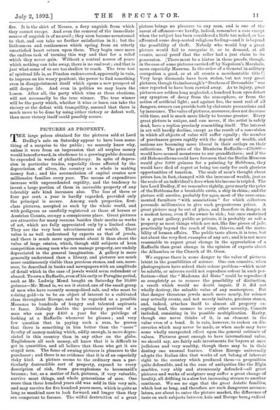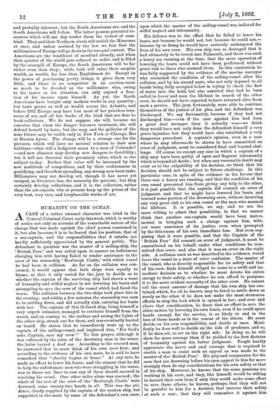PICTURES AS PROPERTY.
rrHE large prices obtained for the pictures sold at Lord Dudley's sale on Saturday appear to have been some- thing of a surprise to the public ; we scarcely know why, unless it were from an impression that all surplus money would henceforward, in obedience to a growing public demand, be expended in works of philanthropy. In spite of depres- sion in particular trades, especially those affected by the depreciation of silver, the country as a whole is making money fast ; and the accumulation of capital creates new millionaire families every year. The means of expenditure increase with unprecedented rapidity, and the tendency to invest a large portion of them in moveable property of any tolerably safe kind increases also. The loss of three or four per cent. a year is hardly regarded, provided only the principal is secure. Among, such properties, first- class pictures, accepted as such by the whole world, and with pedigrees as carefully registered as those of horses or Austrian Counts, occupy a conspicuous place. Great pictures are attractive for many reasons besides their merits as works of art, which are fully appreciated only by a limited class. They are the very best advertisements of wealth. Their value is as well understood by experts as that of jewels, and there is much more agreement about it than about the value of large. estates, which, though still subjects of keen competition among men who can manage property, are unduly depreciated in the general imagination. A gallery is more generally understood than a library, and pictures are much more continuously visible than precious stones, and can, more- over, be described in books and newspapers with an amplitude of detail which in the case of jewels would seem redundant or absurd. To own a Raffaelle, even of his early or Perugino period, such as Mr. Ludwig Mond bought on Saturday for 10,600 guineas—Mr. Mond is, we see it stated, one of the small group of men who have recently monopolised salt, and who must be coining gold—is to be an object of interest to a cultivated class throughout Europe, and to be regarded as a possible Memnas to hundreds of hungry and talented aspirants to fame. Nobody doubts the pecuniary position of a man who can pay 2400 a year for the privilege of looking at a Raffaelle whenever he pleases ; and very few question that in paying such a sum, he proves that there is something in him better than the " mere " faculty of money-making which, oddly enough, is more depre- ciated in this country than in any other on the glo.be. Englishmen all seek money, all know that it is difficult to get in quantities, and all believe that those who get it are stupid men. The fame of owning pictures is pleasure to the purchaser; and there is no evidence that it is of an especially risky kind. A picture seems to the ordinary man a par- ticularly destructible sort of property, exposed to every description of risk, from gas-explosions to housemaid's brooms ; bat, as a matter of fact, pictures, if very valuable, survive most things, and whole generations of men. One more than three hundred years old was sold in this very sale, and may survive for five hundred years more, which is quite BA long as mankind care to look forward, and longer than they are competent to. foresee. The wilful destruction of a great
picture brings no pleasure to any man, and is one of the rarest of offences—we hardly, indeed, remember a case except when the subject has been considered a little too naked, or has affronted some deep-seated religious feeling—and it is beyond the possibility of theft. Nobody who would buy a great picture would fail to recognise it, or to demand, at all events, moral proof that the seller had a just claim to its possession. [There must be a hiatus in these proofs, though, in the case of some pictures carried off by Napoleon's Marshals, more especially Massena. Is the order of a General in military occupation a good, or at all events a merchantable title ?I Very large diamonds have been stolen, but not very great pictures, though Gainsborough's "Duchess of Devonshire "was once reported to have been carried away. As to injury, great pictures are seldom long neglected, a hundred keen eyes detect any symptom of decay from the atmosphere, or from the action of artificial light; and against fire, the most real of all dangers, owners can provide both by elaborate precautions and by insurance. The value of pictures, moreover, does not decrease with time, and is much more likely to become greater. Every great picture is unique, and can never, if the artist is safely dead, have a replica precisely resembling itself. The interest in art will hardly decline, except as the result of a convulsion in which all objects of value will suffer equally ; the number of purchasers grows rapidly with the deposit of wealth, and nations are becoming more liberal in their outlays on their collections. The price of the Blenheim Raffaelle—e70,000- would have seemed monstrous to our grandfathers ; and if the old Hohenzollerns could have foreseen that the Berlin Museum would give 9,600 guineas for a painting by Hobbema, they would have died of regret at being too early for such glorious opportunities of taxation. The scale of men's thought about prices has, in fact, changed with the increase of wealth, just as the scale of an individual's does when his income is tripled. The late Lord Dudley, if we remember rightly, gave nearly the price of the Hobbema for a breakable curio, a ship in china ; and the picture will survive, probably for ages, most of the over-orna- mented furniture "with associations" for which collectors persuade millionaires to give such preposterous prices. A great picture may be out of place, and therefore in danger, in a modest house, even if its owner be rich ; but once enshrined in a great gallery, public or private, it is probably as safe a property as most things which are not, like fine pieces of jade, practically beyond the reach of time, thieves, and the muta- bility of human affairs. The public taste alters, it is true, but not about the very first examples of any art; and it is not more reasonable to expect great change in the appreciation of a. Raffaelle than great change in the opinion of experts about the Alhambra or the Church of St. Ouen.
We suppose there is some danger to the value of pictures latent in the possibilities of science. One can conceive, when photographers have solved their colour problem—which must be soluble, or mirrors could not reproduce colour in such per- fection—that the "Madonna del Sisto " could be reproduced so completely as to remove the possibility of distinction, a result which would no doubt impair, if it did not wholly destroy, the saleable value of any masterpiece. But that danger threatens jewels much more nearly, for science may actually create, and not merely imitate, precious stones, and, indeed, attaches itself to almost all property ex- cepting land, the menace to every other security, Consols included, consisting in its possible multiplication. Rarity, though one never thinks of it, is an element in the value even of a bond. It is vain, however, to reckon on dis- coveries which may never be made, or when made may have some wholly unexpected effect upon the general estimate of values. Pictures great enough to have international value, we should say, are fairly safe investments for buyers at once judicious and very wealthy, though there may be in their destiny one unusual feature. Unless Europe universally adopts the Italian idea that works of art belong of inherent right to the country which produced them—a proposition quite defensible, and in the case of antiquities like the Elgin marbles, very ably and strenuously defended—all great pictures and works of sculpture may suffer a great change of locality, all drifting in a slow but increasing stream to another continent. We see no sign that the great Asiatic families, which last so long, and therefore are such dangerous accumu- lators, are about to enter the picture market, the difference of taste on such subjects between Asia and Europe being radical and probably inherent ; but the North Americans are, and the South Americans will follow. The latter possess potential re- sources which will one day render them the richest of man- kind. They and their Northern rivals will outbid the Museums at once, and unless assisted by the law, we fear that the millionaires of Europe will go down in the unequal contest. The Americans are the wealthiest of mankind already, and when their quarter of the world gets reduced to order, and is filled by the overspill of Europe, the South Americans will be far richer even than they ; while both will value their surplus wealth, as wealth, far less than Englishmen do. Except in the power of purchasing pretty things, it gives them very little, and there is no competitor in an auction-room so much to be dreaded as the millionaire who, owing to his tastes or his situation, can only expend a frac- tion of his income upon himself. As yet, the North Americans have bought only modern works in any quantity ; but taste grows as well as wealth across the Atlantic, and before 1992 Europe may have lost most of her priceless trea- sures of art, and all her books of the kind that are dear to book-collectors. We do not suppose she will, because we conceive that when the danger becomes imminent, she will defend herself by laws ; but she may, and the galleries of the near future may be visible only in New York or Chicago, Rio or Buenos Ayres. The change will be a strange one for the pictures, which will have no natural relation to their new habitats—what will a hedgerow mean to a man of Colorado ? —and new climates may develop new dangers to durability ; but it will not threaten their pecuniary value, which is our subject to-day. Rather that value will be increased by the new multitude of competitors, and by their recklessness in gratifying, and therefore spreading, any strong new-born taste. Billionaires may not develop art, though it has never yet escaped, as literature has, the necessity for patrons ; but they certainly develop collections, and it is the collectors, rather than the art-experts, who at present keep up the prices of the very best, very rare, and irreplaceable works of art.











































 Previous page
Previous page